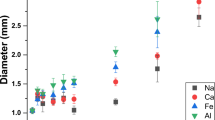Abstract
Several porous chromatographic materials were investigated as synthetic substrates for preparing surrogate nuclear explosion debris particles. Eighteen metals, including some of forensic interest, were loaded onto materials by immersing them in metal solutions (556 mg/L of each metal) to fill the pores, applying gentle heat (110 °C) to drive off water, and then treating them at high temperatures (up to 800 °C) in air to form less soluble metal species. High-boiling-point metals were uniformly loaded on spherical controlled-pore glass to emulate early fallout, whereas low-boiling-point metals were loaded on core–shell silica to represent coated particles formed later in the nuclear fallout-formation process. Analytical studies characterized material balance and the formation of recalcitrant species. Metal loading was 1.5–3 times higher than expected from the pore volume alone, a result attributed to surface coating. Most metals were passively loaded; that is, solutions filled the pores without active metal discrimination. However, niobium and tin concentrations were lower in solutions after pore filling, and were found in elevated concentrations in the final products, indicating selective loading. High-temperature treatments caused reduced solubility of several metals, and the loss of some volatile species (rhenium and tellurium). Sample preparation reproducibility was high (the inter- and intra-batch relative standard deviations were 7.8 and 0.84 %, respectively) indicating suitability for use as a working standard for analytical methods development. We anticipate future standardized radionuclide-loaded materials will find use in radioanalytical methods development and/or serve as a starting material for the synthesis of more complex nuclear explosion debris forms (e.g., Trinitite).





Similar content being viewed by others
References
Glasstone S, Dolan PJ (1977) The effects of nuclear weapons, 3rd edn. US Department of Defense and the Energy Research and Development Administration, Washington, DC
Adams CE, Farlow NH, Schell WR (1960) Geochim Cosmochim Acta 18:42–56
Benson P, Gleit CE, Leventhal L (1965) In: Klement AW, Jr (ed) Radioactive fallout from nuclear weapons tests. Proceedings of the 2nd conference, Germantown, 3–6 Nov 1964. Fallout Studies Branch, Division of Biology and Medicine, U.S. Atomic Energy Commission
Committee on the Effects of Nuclear Earth-penetrator and Other Weapons (2005) Effects of nuclear earth-penetrator and other weapons. National Research Academies, National Academies Press, Washington, DC, p 52
Hawthorne SB, Miller DJ, Burford MD, Langenfeld JJ, Eckert-Tilotta S, Louie PK (1993) J Chromatogr 642:301–317
Harvey SD, Fellows RJ, Cataldo DA, Bean RM (1990) J Chromatogr 518:361–374
O’Brien MJ, Grob RL (1978) J Chromatogr 155:129–148
Harvey SD, Wenzel TJ (2008) J Chromatogr A 1192:212–217
Hauck HE, Mack M, Jost W (1991) In: Sherma J, Fried B (eds) Handbook of thin-layer chromatography, Chromatographic Science Series, vol 55. Marcel Dekker, New York, p 106
Aitzetmüller K, Goncalves LAG (1990) J Chromatogr 519:349–358
Vardoulakis E, Karamanis D, Assimakopoulos MN, Boemi SN, Mihalakakou G (2011) Int J Vent 10:185–194
Li J-R, Kuppler RJ, Zhou H-C (2009) Chem Soc Rev 38:1477–1504
Krenkova J, Foret F, Svec F (2012) J Sep Sci 35:1266–1283
Lei C, Shin Y, Liu J, Ackerman E (2002) J Am Chem Soc 124:11242–11243
Sailor MJ, Park J-H (2012) Adv Mater 24:3779–3802
Gu J, Su S, Zhu M, Li Y, Zhao W, Duan Y, Shi J (2012) Microporous Mesoporous Mater 161:160–167
Santos AMM, Vasconcelos WL (2000) J Non Cryst Solids 273:145–149
Schnable R, Langer P (1991) J Chromatogr 544:137–146
Tyczkowski J, Kapica R, Lojewska J (2007) Thin Solid Films 515:6590–6595
Hadjiev VG, Iliev MN, Vergilov IV (1988) J Phys C Solid State Phys 21:L199–L201
Scott VD, Love G (1983) Quantitative electron-probe microanalysis, 2nd edn. Wiley, New York
Moore JG (1961) J Inorg Nucl Chem 20:166–167
Westphal BR, Batman KJ, Lind RP, Howden KL, Del Cul GD (2005) Fission product removal from spent oxide fuel by head-end processing, Global 2005. Idaho National Laboratory, Idaho Falls
Westpahl BR, Bateman KJ, Herrmann SD (2007) Top ten reasons for DEOX as a front end to pyroprocessing, 2007 ANS Winter Meeting. Idaho National Laboratory, Idaho Falls
Westphal BR, Bateman KJ, Morgan CD, Berg JF, Crane PJ, Cummings DG, Giglio JJ, Huntley MW, Lind RP, Sell DA (2008) Nucl Technol 162:153–157
Fahey AJ, Zeissler CJ, Newbury DE, Davis J, Lindstrom RM (2010) Proc Natl Acad Sci USA 107:20207–20212
Bellucci JJ, Simonetti A (2012) J Radioanal Nucl Chem 293:313–319
Beitz JV, Williams CW (2001) Solvent Extr Ion Exc 19:699–723
Acknowledgments
The National Nuclear Security Administration, Office of Nonproliferation and Engineering, NA-22, supported this work under an Interagency Agreement with the U.S. Department of Energy (DOE) under Contract DE-AC05-75RLO1830. The views, opinions, and findings contained within this paper are those of the authors and should not be construed as an official position, policy, or decision of the DOE or NA-22 unless designated by other documentation. The authors wish to thank Tony Kao of Phenomenex for facilitating purchase of bulk Kinetex HELIC core–shell silica and providing Brunauer, Emmett, and Teller characterization data for this material.
Author information
Authors and Affiliations
Corresponding author
Rights and permissions
About this article
Cite this article
Harvey, S.D., Liezers, M., Antolick, K.C. et al. Porous chromatographic materials as substrates for preparing synthetic nuclear explosion debris particles. J Radioanal Nucl Chem 298, 1885–1898 (2013). https://doi.org/10.1007/s10967-013-2563-2
Received:
Published:
Issue Date:
DOI: https://doi.org/10.1007/s10967-013-2563-2




